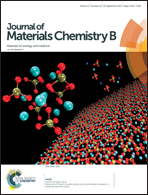β-Ni(OH)2 nanosheets: an effective sensing platform for constructing nucleic acid-based optical sensors†
Abstract
In this study, beta nickel hydroxide (β-Ni(OH)2) nanosheets, one of the transition metal oxyhydroxides with two dimensional (2D) structures, were explored as a new fluorescent biosensor platform and applied in constructing optical sensors for bioanalysis. It was found that β-Ni(OH)2 nanosheets displayed a high fluorescence quenching ability and different affinity toward single- versus double-stranded DNA. Moreover, the absorption properties of β-Ni(OH)2 nanosheets can be well controlled by changing cations, solution pH and the length of DNA. In comparison with some reported 2D nanosheet platforms (e.g. graphene, metal chalcogenides), the absorbed DNA can also be desorbed by degrading the β-Ni(OH)2 nanosheets, which is a simple but effective DNA desorption method. Based on these findings, a sensitive and selective optical miRNA sensor with a detection limit of 1 pM was demonstrated by combining the fluorescence quenching ability of β-Ni(OH)2 nanosheets and duplex-specific nuclease signal amplification. The presented sensor has been successfully used for miRNA analysis in samples containing cancer cells and shown great potential in multiplexed miRNA analysis for clinical diagnosis.



 Please wait while we load your content...
Please wait while we load your content...